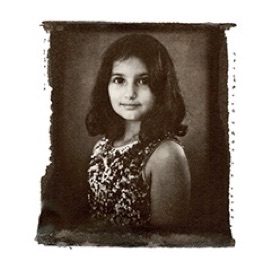21st MCC Analogue Photography Exhibition
Mat Hughes
 |
Print title: Almost 9, 2021 Camera: Kodak Specialist No.2 5×7 studio camera fitted with a Packard shutter. Industar 300mm lens. Film: Fomapan 200 black & white negative film (rated at 200 asa) Lighting: Continuous tungsten, 2 heads Exposure: ½ sec (+/-Packard shutter) @ f 11.5 Exposure includes bellows extension factor: +1 stopDevelopment (semi stand): Prewash in water 4 min. Developer: 510 Pyro @ 20C. Dilution 1:300. Agitation: first 90 sec then 30 sec at 30-minute mark. Stop bath: Water 30 sec. Fix: Fotospeed FX30 1:4 for 4 minutesPost Processing: Van Dyke Brown from digital negative. 5×7 negative digitized with Nikon D800. Processed with Adobe Lightroom and Photoshop. Exported and printed on to Permajet transparent film substrate as a digital negative.Paper type: Hahnemuhle 300gsm Platinum rag. Double coated with Van Dyke Brown solution and 1 drop 1% potassium dichromate per coat.Print Process: Contact printed under UV light for 1.30 min. Standard VDB development process: two slightly acidic water baths/Wash/Sodium thiosulphate/wash/Hypo/Wash Print finishing: Varnished with hand ground raw gum Arabic. Artist statement The principal thing I’m testing for here is a ‘repeatable studio set up that is conducive to achieving an exposure that captures a specific set of skin tone values’, as described by the 1950’s Hollywood photographer, William Mortensen. Bill to his mates. Billy’s process primarily revolves around the careful combination of; low contrast lighting, highlight underexposure, and ultra-long development. It is an exacting and difficult process to follow since the majority of film types and chemical products described in his texts no longer exist. Unlike Billy-Boy Morty, I am using a large format camera which brings an additional set of technical challenges into the studio workflow. Tests are a vital aspect to any project. This first attempt has not only confirmed many elements of the process usable but has also uncovered areas for improvement. These include minor changes to lighting, which will help improve depth of field, and aesthetic improvements such as compositional breathing space for the sitter and zones of interest within the overall framing. This print has been rendered as a Van Dyke Brown out of necessity, owing to the Covid 19 lockdown situation in Melbourne and the lack of darkroom access. I envisage future images presented as some type of silver gelatin print although that remains to be seen. Whilst the Van Dyke Brown process brings an interesting twist with its soft and gritty print aesthetics, it also does a good job concealing a great deal of the highlight tonal range which is the very point of this specific exposure and exercise. For me this image is, on the one hand simply a test that needs reading through the lines and on the other hand is a great little family portrait of our daughter aged 8 years old.
|
